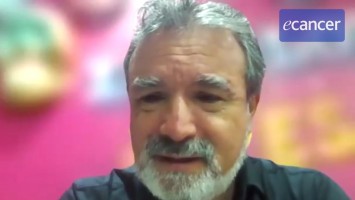What we are doing starts from the consideration that the major unsolved issue in cancer biology remains the inner ability of malignant tumour cells to disseminate, to acquire the capacity of migrating, of becoming a motile entity that moves from the original site where the tumour has grown to disseminate to distant sites, generating what is defined as metastases.
Once this has occurred we all know that the tumour becomes almost untreatable with the current therapeutic strategy and becomes the problem to solve, particularly for these late stage malignant tumours.
So what we are trying to do is to try to understand the basic mechanisms that are acquired during the progression of malignant tumours that makes them able to constantly disseminate and deal with the variety of obstacles that our body puts in place in order to confine the tumour growth to a specific site.
What we have learned in the last couple of decades is that tumours actually, unfortunately, utilise a variety of different mechanisms to move within our body.
The traditional view that indicated that the tumour acquired, for instance, mesenchymal properties to disseminate has been challenged because tumours not only disseminate by separating from the tumour mass but sometimes they actually like to travel in groups, they maintain cell-cell interaction, they do not undergo a canonical transition to a mesenchymal state which is generally considered as the migratory state.
That enables the entire tumour cohort to disseminate in order to reach either the lymphatic or the blood vessels which really represent the major highway through which long distance dissemination can take place.
The whole problem is complicated by the fact that as it has emerged with respect to the inner properties of all tumours, tumours are extremely heterogeneous and such heterogeneity also applies to the mode of migration.
So the best analogy that always comes to mind is when we go to work we can utilise different means of transportation; we can go by foot, we can take a bike, we can take our public transportation.
If there is a strike we are not blocked in our ability to move from A to B, we simply utilise a different means of locomotion.
Talking about locomotion, that’s exactly what tumours do; they utilise a variety of different means of moving within our body, frequently exploiting some of the physical features that the surrounding of a tumour offer to tumour cells in order to move.
This later notion is actually an older notion.
If you think about the way tumours were detected, they were primarily detected by touch, so tumour lumps.
Tumour is a Latin word that means overgrowth; it is applied in many different instances.
The fact that we can detect it by touch indicates that tumours or tumour surroundings are more rigid and rigidity, stiffness, is a specific physical property.
So we have learned, for instance, that the more rigid is the tumour environment, the more malignant is the tumour.
This is a very interesting concept because it implies that there is a constant interplay and crosstalk between the tumour that develops and the environment whereby the tumours constantly modify their environment, for instance makes the environment extremely rich in a collagen type of structure, frequently and generally what is defined as a stromal reaction.
The stromal reaction changes the microenvironment, makes it more rigid, and this rigidity feeds back on the tumour biochemically as well as physically, promoting its ability to disseminate.
I’m stressing this point because it has become clear recently that to address these issues which imply not only canonical genetic and biochemical experiment but also to look at the tumour entity as such as a group, as a whole, that is in a constant state of physical interaction with its microenvironment.
When we talk about physical interaction we talk about physical parameters like rigidity, like stiffness, like motility.
In order to be able to understand these parameters it becomes essential to team up with expertise and people that have gained a background in canonical physics.
One of these opportunities, or this opportunity, can be achieved either by each individual researcher collaborating with an expert in a different field or it can be promoted, as IFOM has done, by fostering this type of interaction.
The way we foster this interaction has been by establishing a formal, initially, but then a scientific interaction with the institute which was established in Singapore a few years ago, the Mechanobiology Institute, whose aim is to exactly define what are the physical parameters which allow a cell to try, not necessarily a tumour, what are the physical interactions and properties which allow a single cell to divide, to become motile, to decide whether to move as an individual as opposed to as a collective entity.
In order to do that you need to develop novel methodology, a novel conceptual approach which takes into account the physical basic laws.
This expertise is all present in the Mechanobiology Institute and by combining this expertise with our approach to tumour biology where we believe we know a lot about some basic biochemical and genetic principles that drive tumour development to a position with metastatic and disseminating ability with a basic outlook where physical parameters are taken into consideration in order to explain the complexity of tumour tissues.








